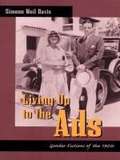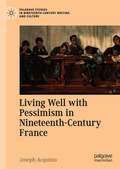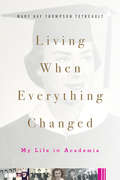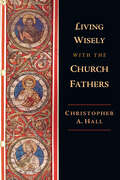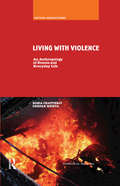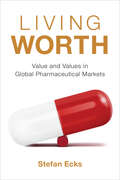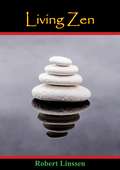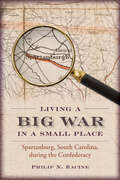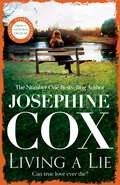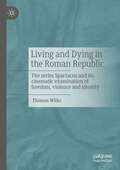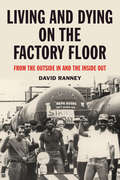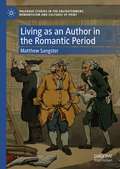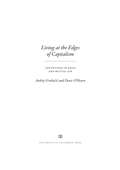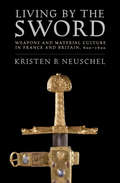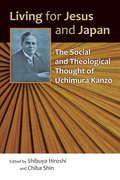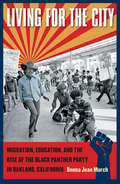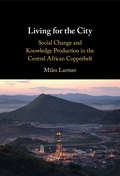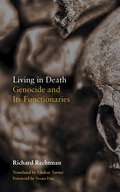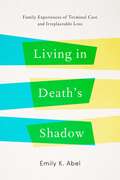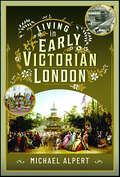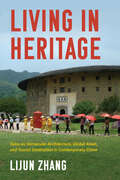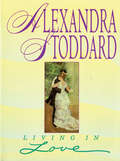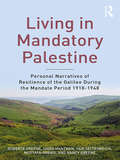- Table View
- List View
Living Up to the Ads: Gender Fictions of the 1920s
by Simone Weil DavisIn Living Up to the Ads Simone Weil Davis examines commodity culture's impact on popular notions of gender and identity during the 1920s. Arguing that the newly ascendant advertising industry introduced three new metaphors for personhood--the ad man, the female consumer, and the often female advertising model or spokesperson--Davis traces the emergence of the pervasive gendering of American consumerism. Materials from advertising firms--including memos, manuals, meeting minutes, and newsletters--are considered alongside the fiction of Sinclair Lewis, Nella Larsen, Bruce Barton, F. Scott Fitzgerald, and Zelda Fitzgerald. Davis engages such books as Babbitt, Quicksand, and Save Me the Waltz in original and imaginative ways, asking each to participate in her discussion of commodity culture, gender, and identity. To illuminate the subjective, day-to-day experiences of 1920s consumerism in the United States, Davis juxtaposes print ads and industry manuals with works of fiction. Capturing the maverick voices of some of the decade's most influential advertisers and writers, Davis reveals the lines that were drawn between truths and lies, seduction and selling, white and black, and men and women. Davis's methodology challenges disciplinary borders by employing historical, sociological, and literary practices to discuss the enduring links between commodity culture, gender, and identity construction. Living Up to the Ads will appeal to students and scholars of advertising, American studies, women's studies, cultural studies, and early-twentieth-century American history.
Living Well with Pessimism in Nineteenth-Century France (Palgrave Studies in Nineteenth-Century Writing and Culture)
by Joseph AcquistoThis book traces the emergence of modern pessimism in nineteenth-century France and examines its aesthetic, epistemological, ethical, and political implications. It explores how, since pessimism as a worldview is not empirically verifiable, writers on pessimism shift the discussion to verisimilitude, opening up rich territory for cross-fertilization between philosophy and literature. The book traces debates on pessimism in the nineteenth century among French nonfiction writers who either lauded its promotion of compassion or condemned it for being a sick and unliveable attempt at renunciation. It then examines the way novelists and poets take up and transform these questions by portraying characters in lived situations that serve as testing grounds for the merits or limitations of pessimism. The debate on pessimism that emerged in the nineteenth century is still very much with us, and this book offers an interhistorical argument for embracing pessimism as a way of living well in the world, aesthetically, ethically, and politically.
Living When Everything Changed: My Life in Academia
by Mary Kay TetreaultEntering the academy at the dawn of the women’s rights movement in the late 1960s and early 1970s, the first generation of feminist academics had a difficult journey. With few female role models, they had to forge their own path and prove that feminist scholarship was a legitimate enterprise. Later, when many of these scholars moved into administrative positions, hoping to reform the university system from within, they encountered entrenched hierarchies, bureaucracies, and old boys’ networks that made it difficult to put their feminist principles into practice. In this compelling memoir, Mary Kay Thompson Tetreault describes how a Catholic girl from small-town Nebraska discovered her callings as a feminist, as an academic, and as a university administrator. She recounts her experiences at three very different schools: the small progressive Lewis & Clark College, the massive regional university of Cal State Fullerton, and the rapidly expanding Portland State University. Reflecting on both her accomplishments and challenges, she considers just how much second-wave feminism has transformed academia and how much reform is still needed. With remarkable candor and compassion, Thompson Tetreault provides an intimate personal look at an era when both women’s lives and university culture changed for good. The Acknowledgments were inadvertently left out of the first printing of this book. We apologize for the oversight, and offer them here instead. Future printings will include this information. (https://d3tto5i5w9ogdd.cloudfront.net/wp-content/uploads/2019/08/29185420/Thompson-Tetreault-Acknowledgments.pdf)
Living Wisely with the Church Fathers
by Christopher A. HallThe first centuries of Christianity are like a far country. But despite their foreignness, they hold a treasury of wisdom for living. Early Christians struggled and flourished in a culture that was in love with empire and military power, infatuated with sex and entertainment, tolerant of all gods but hostile to the One. And from this crucible of discipleship they extracted lessons of virtue, faithfulness, and joy in Christ. Christopher Hall takes us to this distant time, where he interviews Christian leaders around the ancient Mediterranean world, inquiring how to live a good life as a Christ follower. The menu of topics wends its way through wealth and poverty, war and violence, marriage and sexuality, theater and the arena, as well as the harsh realities of persecution and martyrdom. Gathering around Basil or Chrysostom or Augustine, we are instructed anew in the way of discipleship. And as they grapple with issues surprisingly resonant with our own, this cloud of ancient witnesses both surprises and challenges us in the life of faith.
Living With Violence: An Anthropology of Events and Everyday Life (Critical Asian Studies)
by Roma Chatterji Deepak MehtaThis book gives a detailed account of the ‘communal riots’ between Hindus and Muslims in Mumbai in 1992-93. It departs from the historiography of the riot, which assumes that Hindu-Muslim conflict is independent of the participants of the violence.Speaking to and interacting with the residents of Dharavi, the largest shanty town in the city, the authors collected a wide range of narrative accounts of the violence and the procedures of rehabilitation that accompanied the violence. The authors juxtapose these narrative accounts with public documents exploring the role language, work, housing and rehabilitation have on the day-to-day life of people who live with violence.
Living Worth: Value and Values in Global Pharmaceutical Markets (Critical Global Health: Evidence, Efficacy, Ethnography)
by Stefan EcksIn Living Worth Stefan Ecks draws on ethnographic research on depression and antidepressant usage in India to develop a new theory of value. Framing depressive disorder as a problem of value, Ecks traces the myriad ways antidepressants come to have value, from their ability to help make one’s life worth living to the wealth they generate in the multibillion-dollar global pharmaceutical market. Through case studies that include analyses of the different valuation of generic and brand-name drugs, the origins of rising worldwide depression rates, and the marketing, prescription, and circulation of antidepressants, Ecks theorizes value as a process of biocommensuration. Biocommensurations—transactions that aim or claim to make life better—are those forms of social, medical, and corporate actions that allow value to be measured, exchanged, substituted, and redistributed. Ecks’s theory expands value beyond both a Marxist labor theory of value and a free market subjective theory, thereby offering new insights into how the value of lives and things become entangled under neoliberal capitalism.
Living Zen [Second Edition]
by Robert LinssenLiving Zen is that rare achievement, both a survey of the rich history of Zen Buddhism and a guide to the practice of this most demanding and effortless art of being. The distinguished Belgian scholar Robert Linssen offers a sage corrective to the idea that the Zen way is available only to those prepared to sit life out under the Bodhi-Tree. Gently but insistently he undermines this typically Western view; inviting and enabling us, as Christmas Humphreys puts it in his preface, to take "the leap from thought to No-thought, from the ultimate duality of Illusion/Reality to a burst of laughter and a cup of tea.""Linssen's aim throughout this penetrating book is to encourage his readers to outgrow the cocoon of self-centered thought and feeling. The core of the book lies in its lucid analysis...and in the meaning which it gives to the true attention, focused undesirously in the immediate present, which can dissolve the endless distractions of the fear-conditioned ego."--The Times Literary Supplement"Robert Linssen finally gives a sensible explanation of what Zen is all about."--Saturday Review"An excellent study."--San Francisco Chronicle
Living a Big War in a Small Place: Spartanburg, South Carolina, during the Confederacy
by Philip N. RacineA history of life in one South Carolina city during the American Civil War, featuring personal stories from those who were there.Most of what we know about how the Civil War affected life in the Confederacy is related to cities, troop movements, battles, and prominent political, economic, or military leaders. Far less is known about the people who lived in small Southern towns remote from marching armies or battles. Philip N. Racine explores life in one such place—Spartanburg, South Carolina—in an effort to reshape the contours of that great conflict.By 1864 life in most of the Confederacy, but especially in rural towns, was characterized by scarcity, high prices, uncertainty, fear, and bad-tempered neighbors. Shortages of food were common. People lived with constant anxiety that a soldiering father or son would be killed or wounded. Taxes were high, inflation was rampant, good news was scarce and seemed to always be followed by bad. The slave population was growing restive as their masters’ bad news was their good news. Army deserters were threatening lawlessness; accusations and vindictiveness colored the atmosphere and added to the anxiety, fear, and feeling of helplessness. Often people blamed their troubles on the Confederate government in faraway Richmond, Virginia.Racine provides insight into these events through personal stories: the plight of a slave; the struggles of a war widow managing her husband’s farm, ten slaves, and seven children; and the trauma of a lowcountry refugee’s having to forfeit a wealthy, aristocratic way of life and being thrust into relative poverty and an alien social world. All were part of the complexity of wartime Spartanburg District.“A well-written account that not only captures the plight of both the black and white population, but also offers some amazing cameos, especially the life of Emily Lyle Harris, who struggled to keep her large family in tact while her husband went off to war. This is a lively read and a perfect book to assign for classes covering the Carolina Upstate during the American Civil War.” —Edmund L. Drago, professor of history, The College of Charleston, and author of Confederate Phoenix: Rebel Children and Their Families in South Carolina“Living a Big War offers a fascinating, unflinching look at the toll the Civil War took on Spartanburg, clearly showing divisions that emerged and deftly employing stories of slaves, women, and other individuals to reveal the experiences of people on the home front.” —Gaines M. Foster, dean, College of Humanities and Social Sciences, Louisiana State University, and author of Ghosts of the Confederacy: Defeat, the Lost Cause and the Emergence of the New South, 1865–1913
Living a Lie: An utterly captivating saga of the power of true love
by Josephine CoxIs Kitty Marsh living a lie when she tries to keep her first love in the past? In Living a Lie, Josephine Cox weaves a heart-wrenching saga of a young woman leaving behind more than she bargained for. Perfect for fans of Kitty Neale and Dilly Court.In 1975 Lucinda Marsh throws herself in front of a speeding train leaving her twelve-year-old daughter Kitty alone, confused and abandoned - save for a selfish aunt, a violent father and her childhood sweetheart Harry Jenkins.When Kitty is sent to an orphanage after the death of her father, she meets Georgie, a lively cockney girl who, through the following difficult years, becomes her loyal friend. Convinced that her feelings for Harry will ruin the brilliant future that lies ahead of him, Kitty turns her back on his love. Together with Georgie, she strives to find fulfilment in other places and other relationships, but when fate throws her back together with Harry she begins to wonder if true love can ever die...What readers are saying about Living a Lie: 'This is a delightful story of friendship through thick and thin. There is plenty of heartache but also true romance... I personally consider this to be [Josephine Cox's] most well thought out and lovingly created masterpiece''The author drew me in to the plot from the first sentence...In this book you will find themes of coming of age, romance and strength through adversity''Couldn't put this book down. Emotional ups and downs and totally addictive'
Living a Lie: An utterly captivating saga of the power of true love
by Josephine CoxIs Kitty Marsh living a lie when she tries to keep her first love in the past? In Living a Lie, Josephine Cox weaves a heart-wrenching saga of a young woman leaving behind more than she bargained for. Perfect for fans of Kitty Neale and Dilly Court.In 1975 Lucinda Marsh throws herself in front of a speeding train leaving her twelve-year-old daughter Kitty alone, confused and abandoned - save for a selfish aunt, a violent father and her childhood sweetheart Harry Jenkins.When Kitty is sent to an orphanage after the death of her father, she meets Georgie, a lively cockney girl who, through the following difficult years, becomes her loyal friend. Convinced that her feelings for Harry will ruin the brilliant future that lies ahead of him, Kitty turns her back on his love. Together with Georgie, she strives to find fulfilment in other places and other relationships, but when fate throws her back together with Harry she begins to wonder if true love can ever die... What readers are saying about Living a Lie: 'This is a delightful story of friendship through thick and thin. There is plenty of heartache but also true romance... I personally consider this to be [Josephine Cox's] most well thought out and lovingly created masterpiece''The author drew me in to the plot from the first sentence...In this book you will find themes of coming of age, romance and strength through adversity''Couldn't put this book down. Emotional ups and downs and totally addictive'
Living and Dying in the Roman Republic: The Series Spartacus and its Cinematic Examination of Freedom, Violence and Identity
by Thomas WilkeThis volume deals with the American production "Spartacus" and the British-American-Italian co-production Rome. In the examination of the present, a turn to Greek or Roman antiquity can be observed again and again. To find there the roots of Western society for politics, economics or philosophy, or to derive comparative arguments for expansionist efforts or decline, is not just part of the rhetorical commonplace. So it is not surprising that the TV series format also takes up this period. Whereas in Rome the attempt is made to work through the historical guidelines in great detail, in Spartacus, apart from the rough sketch of the plot, one can speak of a far-reaching neglect of the historical situation. From a (media) ethical perspective, specific approaches to responsibility, the transmission of values, loyalty, education, self-discipline, and religion can be identified in the series, which can be interpreted as self-statements of the present or the producers.
Living and Dying on the Factory Floor: From the Outside In and the Inside Out
by David RanneyDavid Ranney’s vivid memoir describes his work experiences between 1976 and 1982 in the factories of southeast Chicago and northwest Indiana, one of the heaviest industrial concentrations in the world. The author takes the reader on a walk through the heart of Chicago’s South Side, observing the noise, heavy traffic, the 24-hour restaurants and bars, the rich diversity of people on the streets at all hours of the day and night, and the smell of the highly polluted air. Factory life includes stints at a machine shop, a shortening factory, a railroad car factory, a structural steel shop, a box factory, a chemical plant, and a paper cup factory. Along the way there is a wildcat strike, an immigration raid, shop-floor actions protesting supervisor abuses, serious injuries, a failed effort to unionize, and a murder. Ranney’s emphasis is on race and class relations, working conditions, environmental issues, and broader social issues in the 1970s that impacted the shop floor. Forty years later, the narrator returns to Chicago’s South Side to reveal what happened to the communities, buildings, and the companies that had inhabited them. Living and Dying on the Factory Floor concludes with discussions on the nature of work; racism, race, and class; the use of immigration policy for social control; and our ability to create a just society.
Living as an Author in the Romantic Period (Palgrave Studies in the Enlightenment, Romanticism and Cultures of Print)
by Matthew SangsterThis book explores how authors profited from their writings in the late eighteenth and early nineteenth centuries, contending that the most tangible benefits were social, rather than financial or aesthetic. It examines authors’ interactions with publishers; the challenges of literary sociability; the vexed construction of enduring careers; the factors that prevented most aspiring writers (particularly the less privileged) from accruing significant rewards; the rhetorical professionalisation of periodicals; and the manners in which emerging paradigms and technologies catalysed a belated transformation in how literary writing was consumed and perceived.
Living at a Lighthouse: Oral Histories from the Great Lakes
by Luanne Gaykowski KozmaOral histories talking about the everyday life while living at a lighthouse.
Living at the Edges of Capitalism
by Andrej Grubacic Denis O'HearnSince the earliest development of states, groups of people escaped or were exiled. As capitalism developed, people tried to escape capitalist constraints connected with state control. This powerful book gives voice to three communities living at the edges of capitalism: Cossacks on the Don River in Russia; Zapatistas in Chiapas, Mexico; and prisoners in long-term isolation since the 1970s. Inspired by their experiences visiting Cossacks, living with the Zapatistas, and developing connections and relationships with prisoners and ex-prisoners, Andrej Grubacic and Denis O'Hearn present a uniquely sweeping, historical, and systematic study of exilic communities engaged in mutual aid. Following the tradition of Peter Kropotkin, Pierre Clastres, James Scott, Fernand Braudel and Imanuel Wallerstein, this study examines the full historical and contemporary possibilities for establishing self-governing communities at the edges of the capitalist world-system, considering the historical forces that often militate against those who try to practice mutual aid in the face of state power and capitalist incursion.
Living by the Sword: Weapons and Material Culture in France and Britain, 600–1600
by Kristen Brooke NeuschelSharpen your knowledge of swords with Kristen B. Neuschel as she takes you through a captivating 1,000 years of French and English history. Living by the Sword reveals that warrior culture, with the sword as its ultimate symbol, was deeply rooted in ritual long before the introduction of gunpowder weapons transformed the battlefield.Neuschel argues that objects have agency and that decoding their meaning involves seeing them in motion: bought, sold, exchanged, refurbished, written about, displayed, and used in ceremony. Drawing on evidence about swords (from wills, inventories, records of armories, and treasuries) in the possession of nobles and royalty, she explores the meanings people attached to them from the contexts in which they appeared. These environments included other prestige goods such as tapestries, jewels, and tableware—all used to construct and display status.Living by the Sword draws on an exciting diversity of sources from archaeology, military and social history, literature, and material culture studies to inspire students and educated lay readers (including collectors and reenactors) to stretch the boundaries of what they know as the "war and culture" genre.
Living for Jesus and Japan: The Social and Theological Thought of Uchimura Kanzo
by Shibuya Hiroshi & Chiba ShinUchimura Kanzo (1861–1930) was an independent, original, and thought-provoking pioneer of Christianity in modern Japan. His theological values were organically linked with his aspiration for living and practicing such evangelical ideas as prophetic existence, neighborly love, social justice, pacifism, patriotism, and internationalism in the sphere of public life. Uchimura's commitment to the interaction between religious thought and social life is apparent in his well-known epitaph: "I for Japan; Japan for the World; the World for Christ; and All for God."In this interdisciplinary, multi-angled approach to Uchimura Kanzo, the contributors shed light on the inner logic, meanings, and modes of interaction between the religious and social thought observable in Kanzo.Contributors:Andrew E. BarshayKei ChibaShin ChibaKyougae LeeHiroshi MiuraTsunao OhyamaHiroshi ShibuyaTakashi ShogimenYasuhiro TakahashiKunichika Yagyu
Living for the City: Migration, Education, and the Rise of the Black Panther Party in Oakland, California
by Donna Jean MurchIn this nuanced and groundbreaking history, Donna Murch argues that the Black Panther Party (BPP) started with a study group. Drawing on oral history and untapped archival sources, she explains how a relatively small city with a recent history of African American settlement produced such compelling and influential forms of Black Power politics. During an era of expansion and political struggle in California's system of public higher education, black southern migrants formed the BPP. In the early 1960s, attending Merritt College and other public universities radicalized Huey Newton, Bobby Seale, and many of the young people who joined the Panthers' rank and file. In the face of social crisis and police violence, the most disfranchised sectors of the East Bay's African American community--young, poor, and migrant--challenged the legitimacy of state authorities and of an older generation of black leadership. By excavating this hidden history,Living for the Citybroadens the scholarship of the Black Power movement by documenting the contributions of black students and youth who created new forms of organization, grassroots mobilization, and political literacy.
Living for the City: Social Change and Knowledge Production in the Central African Copperbelt
by Miles LarmerLiving for the City is a social history of the Central African Copperbelt, considered as a single region encompassing the neighbouring mining regions of Zambia and the Democratic Republic of Congo. The Haut Katanga and Zambian Copperbelt mine towns have been understood as the vanguard of urban 'modernity' in Africa. Observers found in these towns new African communities that were experiencing what they wrongly understood as a transition from rural 'traditional' society – stable, superstitious and agricultural – to an urban existence characterised by industrial work discipline, the money economy and conspicuous consumption, Christianity, and nuclear families headed by male breadwinners supported by domesticated housewives. Miles Larmer challenges this representation of Copperbelt society, presenting an original analysis which integrates the region's social history with the production of knowledge about it, shaped by both changing political and intellectual contexts and by Copperbelt communities themselves.
Living in Death: Genocide and Its Functionaries (Thinking from Elsewhere)
by Richard RechtmanWinner, Prix Littéraire Paris-Liège 2021 Winner, French Voices Award for Excellence in Publication and TranslationWhen we speak of mass killers, we may speak of radicalized ideologues, mediocrities who only obey orders, or bloodthirsty monsters. Who are these men who kill on a mass scale? What is their consciousness? Do they not feel horror or compassion?Richard Rechtman’s Living in Death offers new answers to a question that has haunted us at least since the Holocaust. For Rechtman, it is not ideologies that kill, but people. This book descends into the ordinary life of people who execute hundreds every day, the same way others go to the office. Bringing philosophical sophistication to the ordinary, the book constitutes an anthropology of mass killers.Turning away from existing psychological and philosophical accounts of genocide’s perpetrators, Rechtman instead explores the conditions under which administering death becomes a job like any other. Considering Cambodia, Rwanda, and other mass killings, Living in Death draws on a vast array of archival research, psychological theory, and anecdotes from the author’s clinical work with refugees and former participants in genocide. Rechtman mounts a compelling case for reframing and refocusing our attempts to explain—and preempt—acts of mass torture, rape, killing, and extermination.What we must see, Rechtman argues, is that for genocidaires (those who carry out acts that are or approach genocide), there is nothing extraordinary, unusual, or world-historical about their actions. On the contrary, they are preoccupied with the same mundane things that characterize any other job: interactions with colleagues, living conditions, a drink and a laugh at the end of the day. To understand this is to understand how things came to be the way they are—and how they might be different.
Living in Death’s Shadow: Family Experiences of Terminal Care and Irreplaceable Loss
by Emily K. AbelChallenging assumptions about caregiving for those dying of chronic illness.What is it like to live with—and love—someone whose death, while delayed, is nevertheless foretold? In Living in Death’s Shadow, Emily K. Abel, an expert on the history of death and dying, examines memoirs written between 1965 and 2014 by family members of people who died from chronic disease. In earlier eras, death generally occurred quickly from acute illnesses, but as chronic disease became the major cause of mortality, many people continued to live with terminal diagnoses for months and even years. Illuminating the excruciatingly painful experience of coping with a family member’s extended fatal illness, Abel analyzes the political, personal, cultural, and medical dimensions of these struggles.The book focuses on three significant developments that transformed the experiences of those dying and their intimates: the passage of Medicare and Medicaid, the growing use of high-tech treatments at the end of life, and the rise of a movement to humanize the care of dying people. It questions the exalted value placed on acceptance of mortality as well as the notion that it is always better to die at home than in an institution. Ultimately, Living in Death’s Shadow emphasizes the need to shift attention from the drama of death to the entire course of a serious chronic disease. The chapters follow a common narrative of life-threatening disease: learning the diagnosis; deciding whether to enroll in a clinical trial; acknowledging or struggling against the limits of medicine; receiving care at home and in a hospital or nursing home; and obtaining palliative and hospice care. Living in Death’s Shadow is essential reading for everyone seeking to understand what it means to live with someone suffering from a chronic, fatal condition, including cancer, AIDS, Alzheimer’s, and heart disease.
Living in Early Victorian London
by Michael AlpertLondon in the 1840s was sprawling and smoke-filled, a city of extreme wealth and abject poverty. Some streets were elegant with brilliantly gas-lit shop windows full of expensive items, while others were narrow, fetid, muddy, and in many cases foul with refuse and human filth. Railways, stations and sidings were devouring whole districts and creating acres of slums or ‘rookeries’ into which the poor of the city were jammed and where crime, disease and prostitution were rife. The most sensational crime of the epoch, the murder of Patrick O’Connor by Frederick and Maria Manning, filled the press in the summer and autumn of 1849. Michael Alpert uses the trial record of this murder, accompanied by numerous other contemporary sources, among them journalism, diaries and fiction, to show how day-to-day lives, birth, death, sickness, work, shopping, cooking, and buying clothes, were lived in the crowded, noisy capital in the early decades of Victoria’s reign. These sources illustrate how ordinary people lived in London, their incomes, entertainments, religious practice, reading and education, their hopes and anxieties. Life in Early Victorian London reveals how ordinary people like the Mannings and thousands of others experienced their multifaceted lives in the greatest capital city of the world. Early Victorian London lived on the cusp of great improvements, but it was a city which in some aspects was mediaeval. Its inhabitants enjoyed the benefit of the Penny Post and the omnibus, and they were protected to some extent by a police force. The Mannings fled their crime on the railway, were trapped by the recently-invented telegraph and arrested by ‘detectives’ (a new concept and word), but they were hanged in public as murderers had been for centuries, watched by a baying, drunken and swearing mob.
Living in Heritage: Tulou as Vernacular Architecture, Global Asset, and Tourist Destination in Contemporary China (Material Vernaculars)
by Lijun ZhangYongding County in southeast China is famous for its large, multistory communal vernacular buildings known as tulou, translated "rammed earth building." These structures were designated a UNESCO World Heritage Site in 2008. Living in Heritage introduces readers outside of China to this classic example of local Chinese architecture in the context of contemporary heritage preservation and tourism.Focusing on the Yongding Hakka Tulou Folk Culture Village, which is part of Hongkeng Village, author Lijun Zhang examines the on-the-ground processes and effects of heritage-making, UNESCO-inspired tourism, and how locals negotiate the dramatic transformation of their daily, social, and economic lives. Within an age of cultural change beginning at the start of the 21st century, Living in Heritage explores how the tulou phenomenon as heritage has and continues to be transformed into cultural, economic, or political capital. Through her careful study, Zhang reveals how the blurring of formerly distinct domains—private and public, local and global—gives rise to a living museum that now relies on insiders and outsiders to preserve their way of life.Living in Heritage offers an in-depth ethnographic account of the people dwelling and working within traditional tulou architecture in the 21st century.
Living in Love
by Alexandra StoddardWith the warmth and affection that has made her America's favorite lifestyle philosopher, bestselling author Alexander Stoddard shows readers how to find love within themselves, bring love into their lives, and enjoy living a lifetime in love.
Living in Mandatory Palestine: Personal Narratives of Resilience of the Galilee during the Mandate Period 1918–1948
by Nancy Greene Roberta R. Greene Shira Hantman Yair Seltenreich Mustafa AbbasiThis book, the product of a series of 40 interviews with Israelis and Palestinians, describes everyday life in Galilee during the Mandate period. The individual narratives are skillfully embedded in larger historical and social histories by a team of authors who come from diverse academic backgrounds. It offers a glimpse into Israelis’ and Palestinians’ experiences of war and peace and sheds new light on the challenges facing Israeli society today. This work is ideal for scholars and students of the social sciences, particularly those interested in the psychological repercussions of political and social events.
